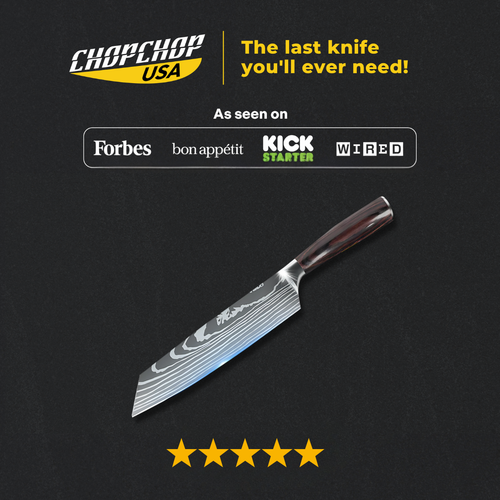Choosing the best cutting board for knives in 2025 involves considering durability, knife safety, and hygiene. Titanium cutting boards are highly recommended because they protect knife edges and offer a smooth cutting experience. Brands like ChopChop USA produce high-quality, knife-friendly boards that minimize blade wear. Investing in the best cutting board for knives ensures your blades stay sharp longer and enhances your overall kitchen experience.
What Makes a Cutting Board Good for Knives?

A good cutting board for knives balances durability, safety, and ease of maintenance. Here are key factors to consider:
Material Matters
When selecting a cutting board, the material plays a crucial role in knife longevity and performance. Titanium cutting boards provide the ideal balance between durability and knife safety, offering a smooth, non-abrasive surface that protects blade sharpness.
Unlike traditional wood options such as maple, walnut, and teak, which can absorb moisture and require frequent conditioning, or plastic boards that wear out over time, titanium is resistant to scratches, stains, and bacterial contamination. This makes it the best cutting board material for those seeking longevity, hygiene, and optimal knife protection.
See more: Best Cutting Board Material For Your Health 2025
Surface Hardness
A cutting board should be soft enough to prevent excessive wear on knives but firm enough to resist deep grooves that can harbor bacteria. Titanium cutting boards are superior in this regard as they naturally heal from knife cuts, making them one of the best cutting board for knives options available today.
Size and Thickness
A larger board allows ample cutting space, preventing accidental slips that could dull or damage knives. A thickness of at least 1.5 inches provides stability and longevity, contributing to the best cutting board for knives experience.
See more: Choosing the Right Chopping Board Size
Non-Slip Stability
A board that moves around while cutting can be hazardous. Many wood and plastic boards feature non-slip edges or rubber grips to enhance safety. Stability is key when selecting the best cutting board for knives to prevent accidents and ensure ease of use.
An anti-slip silicone mat provides a secure grip on countertops, preventing unwanted movement while chopping. This is especially useful for lightweight boards that may shift during use. Simply placing the mat underneath your cutting board enhances safety and control, reducing the risk of slipping and accidental injuries.
Hygiene and Maintenance
Choosing a cutting board with a hygienic and easy-to-maintain surface is essential for food safety. Titanium cutting boards stand out as the best option due to their non-porous nature, which prevents bacterial growth and odor absorption. Unlike wood, which requires regular oiling to prevent drying and cracking, or plastic, which must be replaced when deeply scarred, titanium remains durable and low-maintenance, ensuring long-term use with minimal upkeep.
Brand Reputation
Trusted brands like ChopChop USA design cutting boards that prioritize knife safety, making them an excellent choice for maintaining blade sharpness and kitchen efficiency. When searching for the best cutting board for knives, opting for a reputable brand is essential.
By selecting a board with these qualities, you ensure both your knives and kitchen experience remain in top condition.
Best Cutting Board Materials for Knife Safety

Selecting the right cutting board material is crucial for knife safety. A poorly chosen surface can quickly dull blades and even cause chipping. Below are the best materials to ensure a balance between durability and knife-friendliness:
Titanium
- Pros: Highly durable and resistant to scratches, titanium cutting boards are non-porous and easy to clean. They do not absorb odors or bacteria.
- Cons: Too hard on knife edges, causing them to dull quickly, making it less ideal for maintaining sharpness.
See more: Titanium vs. Stainless Steel Cutting Board – Which Is Better?
Stainless Steel
- Pros: Extremely durable, rust-resistant, and easy to sanitize. Stainless steel boards are often used in industrial kitchens.
- Cons: Very hard surface that dulls knives quickly and does not provide the slight give needed to protect knife edges.
End-Grain Wood
- Pros: End-grain wood, such as maple, walnut, and teak, is considered the best for knives. It provides a soft, self-healing surface that minimizes knife wear and prevents deep grooves from forming.
- Cons: Requires regular maintenance, including oiling to prevent drying and cracking. More expensive than other options.
Edge-Grain Wood
- Pros: More affordable than end-grain, while still being gentler on knives than plastic or glass.
- Cons: More prone to knife marks and requires consistent maintenance to prevent warping.
Bamboo
- Pros: Eco-friendly and sustainable, bamboo is harder than most woods, making it durable. It resists water absorption, reducing bacteria growth.
- Cons: Can be hard on knives, causing them to dull faster than traditional wood.
High-Density Polyethylene (HDPE) Plastic
- Pros: Non-porous, easy to clean, and dishwasher-safe. Often used in professional kitchens.
- Cons: Develops deep grooves over time, requiring regular replacement to maintain hygiene.
Rubber
- Pros: Provides a soft surface that is gentle on knives while being easy to clean and highly durable.
- Cons: Can be heavier and more expensive than plastic alternatives.
Glass and Stone (Avoid These)
- Pros: Easy to clean and visually appealing.
- Cons: Extremely hard surfaces that quickly dull and chip knives, making them unsuitable for kitchen use.
For optimal knife safety, titanium cutting boards like those from ChopChop USA are the best choice. They balance durability, hygiene, and knife-friendliness, making them ideal for professional and home kitchens alike.
Best Cutting Board Brands for Knife Safety

A good cutting board is essential for both food preparation and knife safety. The right board protects your knife’s sharp edge while providing a stable and hygienic surface for cutting. Different materials impact a board’s durability, ease of cleaning, and knife-friendliness. Below, we review some of the best cutting board brands, focusing on their material, benefits, and potential drawbacks.
ChopChop USA

About the Brand:
ChopChop USA is a premium brand known for its innovative approach to cutting board design. They specialize in high-quality, titanium cutting boards, prioritizing both durability and knife safety. Their products cater to professional chefs and home cooks looking for a long-lasting, knife-friendly cutting surface.
Material:
100% Pure Titanium
Pros:
- Titanium coating ensures minimal impact on knife edges, reducing dulling.
- Sustainably sourced hardwoods offer durability and longevity.
- Resistant to deep cuts and grooves, making it more hygienic over time.
Cons:
- Typically more expensive than other cutting boards.
John Boos & Co.

About the Brand:
John Boos & Co. has been a trusted name in professional and home kitchens for over a century. Their cutting boards are made from high-quality hardwoods and are renowned for their craftsmanship and durability. They are a favorite among chefs who need reliable, knife-friendly surfaces for heavy use.
Material
High-quality hardwood (maple, walnut, cherry)
Pros:
- End-grain construction provides a soft surface that preserves knife sharpness.
- Heavy and sturdy, preventing board movement during cutting.
- Premium craftsmanship with excellent durability.
Cons:
- Requires regular oiling and maintenance.
- Can be expensive compared to synthetic alternatives.
Epicurean

About the Brand:
Epicurean specializes in eco-friendly, durable cutting boards made from wood fiber composites. Their boards offer a perfect balance between sustainability, ease of maintenance, and knife-friendliness. They are designed to withstand daily use while being lightweight and easy to clean.
Material
Wood fiber composite
Pros:
- Knife-friendly surface that resists excessive dulling.
- Lightweight and easy to handle.
- Dishwasher-safe and resistant to warping.
Cons:
Royal Craft Wood

About the Brand:
Royal Craft Wood is a well-known brand specializing in bamboo cutting boards. Their products are designed to be eco-friendly, durable, and stylish while providing a safe cutting surface for knives. With a strong focus on sustainability, their boards offer an excellent balance between hardness and knife preservation.
Material
High-quality Bamboo
Pros:
- Eco-friendly and made from sustainable bamboo.
- Naturally antibacterial properties reduce bacterial growth.
- Lightweight yet durable for everyday use.
Cons:
- Harder surface may dull knives faster than softer wood options.
- Requires periodic oiling to prevent cracking and maintain longevity.
Totally Bamboo

Totally Bamboo is a pioneer in bamboo kitchenware, known for producing high-quality, sustainable cutting boards. The brand emphasizes eco-friendliness, using organically grown Moso bamboo, which is naturally resistant to moisture and bacteria. Their cutting boards are designed to be durable, lightweight, and stylish, making them a popular choice for home cooks looking for a sustainable alternative to traditional wood or plastic boards.
Material
Bamboo
Pros:
- Eco-friendly and sustainable choice.
- Naturally resists water absorption, reducing bacterial growth.
- Hard surface makes it durable and long-lasting.
Cons:
- Harder than some wood options, which may dull knives faster.
- Requires maintenance to prevent splitting over time.
Selecting the right cutting board depends on your priorities. If you value sustainability and aesthetics, Teakhaus or Totally Bamboo might be ideal. If ease of cleaning is your main concern, OXO Good Grips or Epicurean offer great options. For professionals seeking premium durability and knife safety, John Boos & Co. and ChopChop USA stand out. Investing in a high-quality cutting board ensures a better cooking experience while extending the lifespan of your knives.
How to Maintain a Knife-Friendly Cutting Board

Proper maintenance is essential to keep your cutting board knife-friendly and hygienic. Follow these steps:
Regular Cleaning
- Wash with warm water and mild soap after each use.
- Avoid soaking wooden boards in water to prevent warping.
Sanitization
- Use a mixture of vinegar and water or hydrogen peroxide to disinfect.
- For plastic boards, occasional dishwasher cleaning helps remove bacteria.
Oiling (For Wood Boards)
- Apply food-grade mineral oil regularly to prevent drying and cracking.
- Use beeswax for added protection.
Avoiding Harsh Surfaces
- Never cut on glass, stone, or ceramic boards to protect knife edges.
Storage
- Store in a dry, well-ventilated area.
- Keep wooden boards upright to prevent moisture buildup.
With proper care, your cutting board will last longer and continue to protect your knives.
Which Cutting Board is Best for Knives?
The best cutting board for knives is one that balances durability, hygiene, and knife safety. Titanium cutting boards, such as those from ChopChop USA, are ideal because they provide a soft, self-healing surface that preserves knife sharpness. High-quality plastic boards are also an option for easy maintenance. By choosing the right board, you extend the life of your knives and enhance your kitchen efficiency.
For more amazing recipes, follow me on Facebook and Instagram! If you have any questions about ChopChop USA's products or promotions, please feel free to contact us at support@chopchopusa.com. Our dedicated team is available 24/7 and always happy to assist you.




